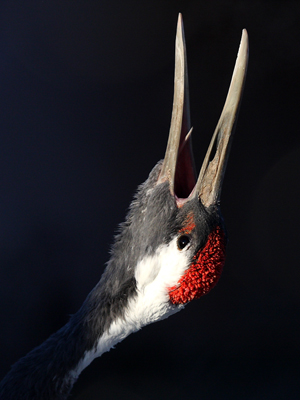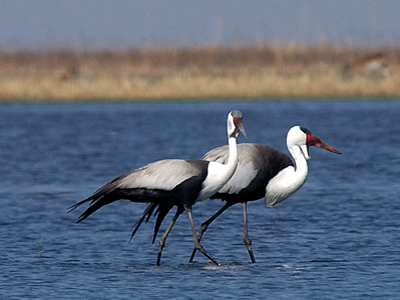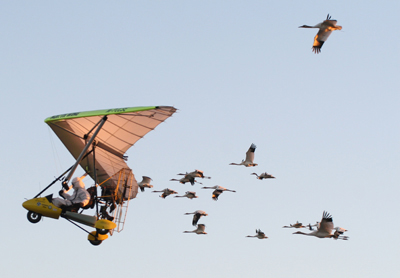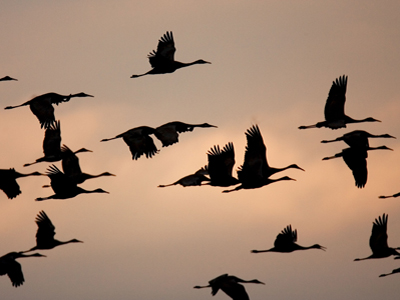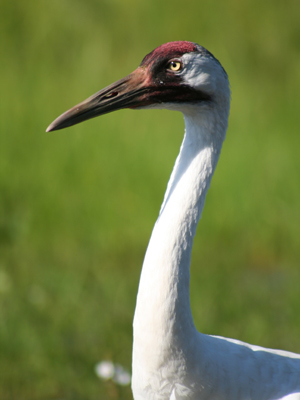 On Sunday, April 15th the International Crane Foundation (ICF) officially opens to visitors and our performers (the cranes) are dusting off their feathers, dancing and bugling to get ready.
On Sunday, April 15th the International Crane Foundation (ICF) officially opens to visitors and our performers (the cranes) are dusting off their feathers, dancing and bugling to get ready.
Category: Press Releases
Major Conservation Victory in Mozambique!
 The International Crane Foundation (ICF), together with World Wide Fund for Nature (WWF) and the Museum of Natural History and other key partners in Mozambique, congratulate the Government of Mozambique for their wise decision to not allow the dredging of the lower Zambezi River and Delta for coal barging.
The International Crane Foundation (ICF), together with World Wide Fund for Nature (WWF) and the Museum of Natural History and other key partners in Mozambique, congratulate the Government of Mozambique for their wise decision to not allow the dredging of the lower Zambezi River and Delta for coal barging.
ICF’s President and CEO, Dr. Richard Beilfuss, was deeply involved in preparing the Environmental Impact Assessment and subsequent communications with the Mozambique Ministry of Environment concerning the need for a holistic, ecosystems approach to Zambezi River basin development.
Ultralight-led Whooping Cranes will be Released on Wheeler NWR
 Nine juvenile Whooping Cranes on their first ultralight-led migration south will be taken to Wheeler National Wildlife Refuge (NWR) in Morgan County, Ala. in the next few days. The nine Whooping Cranes will be placed in travel enclosures and loaded onto vehicles as soon as possible. They will be driven about 70 miles from Winston County, Ala., to Wheeler NWR. The cranes will be temporarily housed in a secure pen, during which time they will be fitted with identification bands and tracking transmitters. The young birds will then be released in the company of other Whooping Cranes that have been wintering at the refuge.
Nine juvenile Whooping Cranes on their first ultralight-led migration south will be taken to Wheeler National Wildlife Refuge (NWR) in Morgan County, Ala. in the next few days. The nine Whooping Cranes will be placed in travel enclosures and loaded onto vehicles as soon as possible. They will be driven about 70 miles from Winston County, Ala., to Wheeler NWR. The cranes will be temporarily housed in a secure pen, during which time they will be fitted with identification bands and tracking transmitters. The young birds will then be released in the company of other Whooping Cranes that have been wintering at the refuge.
Sandhill Crane Hunt Update
 In early February 2012 Wisconsin State Representative Joel Kleefisch introduced a bill proposing a regulated Sandhill Crane hunt in the state. The following update summarizes ICF’s role in the ongoing discussion of this issue.
In early February 2012 Wisconsin State Representative Joel Kleefisch introduced a bill proposing a regulated Sandhill Crane hunt in the state. The following update summarizes ICF’s role in the ongoing discussion of this issue.
Our Position: The International Crane Foundation does not endorse or oppose Sandhill Crane hunting in North America. We recognize the role of regulated hunting in current wildlife population management practices, and the importance of hunting traditions to communities, not just on this continent, but globally. We maintain three strong positions relative to crane hunting.
Aransas Refuge Reports on Whooping Crane Status in Texas
 This has been a busy month for Whooping Crane activity since our last report. Aransas National Wildlife Refuge has received an additional 0.72 inches of precipitation and salinity levels remain higher than ideal. We have continued to help alleviate the low food resources by adding to our prescribed burn totals. This week alone we have burned an additional 4,682 acres of Whooping Crane habitat. Biologists observed the Whooping Cranes eating roasted acorns and are seeing continued usage.
This has been a busy month for Whooping Crane activity since our last report. Aransas National Wildlife Refuge has received an additional 0.72 inches of precipitation and salinity levels remain higher than ideal. We have continued to help alleviate the low food resources by adding to our prescribed burn totals. This week alone we have burned an additional 4,682 acres of Whooping Crane habitat. Biologists observed the Whooping Cranes eating roasted acorns and are seeing continued usage.
Wildlife Agency Urges Crane Spectators to Maintain Distance
 As a pair of Whooping Cranes remains in North Carolina’s Clay County, the U.S. Fish & Wildlife Service urges spectators to maintain their distance in order to not spook the cranes and reduce their familiarity with humans.
As a pair of Whooping Cranes remains in North Carolina’s Clay County, the U.S. Fish & Wildlife Service urges spectators to maintain their distance in order to not spook the cranes and reduce their familiarity with humans.
“These cranes are among the rarest animals on the planet. In our efforts to recover this species, I can’t stress enough how important it is for people to give the birds the space they need to feel comfortable and go peacefully about their daily lives of finding food, water, shelter, and developing the bond that will lead to successful nesting in the spring,” said Bill Brooks, a biologist with the U.S. Fish & Wildlife Service.
Whooping Crane Shot in Indiana
 The International Crane Foundation (ICF) is saddened to learn of the shooting of male Whooping Crane #6-05 from the eastern migratory population. Number 6-05 was found dead on December 30 near Crothersville, Indiana. He was paired with DAR (Direct Autumn Release) Whooping Crane #37-09. Number 6-05 is the eighth Whooping Crane to be senselessly shot in the past year (two were shot in the non-migratory population in Louisiana and six in the eastern migratory population).
The International Crane Foundation (ICF) is saddened to learn of the shooting of male Whooping Crane #6-05 from the eastern migratory population. Number 6-05 was found dead on December 30 near Crothersville, Indiana. He was paired with DAR (Direct Autumn Release) Whooping Crane #37-09. Number 6-05 is the eighth Whooping Crane to be senselessly shot in the past year (two were shot in the non-migratory population in Louisiana and six in the eastern migratory population).

